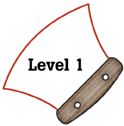|
National Science Education Standards
Ask a question about objects, organisms, and events in the environment.
This aspect of the standard emphasizes students asking questions that
they can answer with scientific knowledge, combined with their own observations.
Students should answer their questions by seeking information from reliable
sources of scientific information and from their own observations and
investigations. (Page 122)
Scientific investigations involve asking and answering a question and
comparing the answer with what scientists already know about the world.
(Page 123)
|
|
Benchmarks
In doing science, it is often helpful to work with a team and to share
findings with others. All team members should reach their own individual
conclusions, however, about what the findings mean. (Page 15)
Raise questions about the world around them and be willing to seek answers
to some of them by making careful observations and trying things out.
(Page 285)
|


